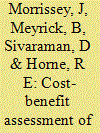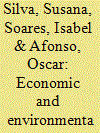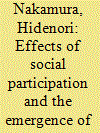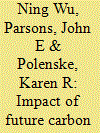|
|
|
Sort Order |
|
|
|
Items / Page
|
|
|
|
|
|
|
| Srl | Item |
| 1 |
ID:
118822


|
|
|
|
|
| Publication |
2013.
|
| Summary/Abstract |
Diesel vehicles offer greater fuel-efficiency and lower greenhouse gas emissions at a time when national governments seek to reduce the energy and climate impacts of the vehicle fleet. Policies that promote diesels like preferential fuel taxes, fuel economy standards and greenhouse gas emission standards can produce higher emissions of diesel particulate matter if diesel particulate filters or equivalent emission control technology is not in place. This can undermine the expected climate benefits of dieselization and increase impacts on public health. This paper takes a historical look at Europe to illustrate the degree to which dieselization and lax controls on particulate matter can undermine the potential benefits sought from diesel vehicles. We show that countries on the dieselization pathway can fully capture the value of diesels with the adoption of tailpipe emission standards equivalent to Euro 6 or Tier 2 for passenger cars, and fuel quality standards that limit the sulfur content of diesel fuel to no greater than 15 ppm. Adoption of these policies before or in parallel with adoption of fuel consumption and greenhouse gas standards can avert the negative impacts of dieselization.
|
|
|
|
|
|
|
|
|
|
|
|
|
|
|
|
| 2 |
ID:
118846


|
|
|
|
|
| Publication |
2013.
|
| Summary/Abstract |
China's CO2 emission has attracted world's attention in the last few years for its rapid increase. It is necessary to analyze the current situation of China's carbon emission for its CO2 reduction. Carbon flow chart is an intuitive and quantitative tool for showing a whole picture of CO2 flows and emissions data. According to the IPCC method, the authors analyze China's CO2 emissions and draft China's CO2 flow chart for 2008. We find that: (1) China's CO2 emissions increase fast, while its CO2 intensity declines continuously in most years; (2) CO2 emissions from industry and construction account for 76.67% of the total CO2 emissions of terminal sub-sectors, in which ferrous metal industry emits the largest amount; (3) coal maintains as the largest emission source of CO2 from the point of view of fuel type in China, accounting for 78.20% of the total primary CO2 flow; (4) process emissions are considerable and (5) it is necessary to adjust the primary energy mix in China for energy-related CO2 reduction.
|
|
|
|
|
|
|
|
|
|
|
|
|
|
|
|
| 3 |
ID:
118853


|
|
|
|
|
| Publication |
2013.
|
| Summary/Abstract |
This paper compares the policy relevance and derives mathematical relationships between three approaches for GHG emissions accounting for cities. The three approaches are: (a) Purely-Geographic Inventory, (b) Trans-boundary Community-Wide Infrastructure Footprint (CIF), and (c) Consumption-Based Footprint (CBF). Mathematical derivations coupled with case study of three US communities (Denver Colorado, Routt Colorado, and Sarasota Florida), shows that no one method provides a larger or more holistic estimate of GHG emissions associated with communities. A net-producing community (Routt) demonstrates higher CIF GHG emissions relative to the CBF, while a net-consuming community (Sarasota) yields the opposite. Trade-balanced communities (Denver) demonstrate similar numerical estimates of CIF and CBF, as predicted by the mathematical equations. Knowledge of community typology is important in understanding trans-boundary GHG emission contributions.
|
|
|
|
|
|
|
|
|
|
|
|
|
|
|
|
| 4 |
ID:
118854


|
|
|
|
|
| Publication |
2013.
|
| Summary/Abstract |
The beneficial results of the exponential expansion of photovoltaic installations in Germany and Italy are discussed. Remarkable falls in the peak price of electricity have been observed in both countries. The reasons are discussed in the light of the data from the Kombikraftwerk project. This has demonstrated, in a scaled, real-time experiment, how the demand on the German grid can be met by photovoltaics and wind with back-up from biogas and (pumped hydro) storage. We discuss the implications of the fall in price of photovoltaic cells particularly for 3rd generation technology. Using the specific example of the UK, we demonstrate the advantages of the complementary nature of wind and photovoltaic resources. We demonstrate that the wind and photovoltaic capacity targets for an all renewably powered UK are likely to be significantly lower than in Germany. We conclude by summarising the evidence in favour of a moratorium on all new electricity generation other than by the renewables.
|
|
|
|
|
|
|
|
|
|
|
|
|
|
|
|
| 5 |
ID:
118850


|
|
|
|
|
| Publication |
2013.
|
| Summary/Abstract |
Nigeria's economy is largely dependent on petroleum, yet the country is suffering from fuel supply shortages. In response to the transportation fuel supply difficulties in Nigeria, the country released the Nigerian Biofuel Policy and Incentives in 2007 to create favorable investment climate for the entrance of Nigeria into the biofuel sector. The paper assessed the progress made thus far by Nigeria, 4 years after the Nigerian biofuel was released in an attempt to answer the question whether the policy is adequate to transform Nigeria into a biofuel economy. The study found that little progress has been made, which includes commencement of the construction of 20 bioethanol factories, installation of biofuel handling facilities at two depots (Mosimi and Atlas Cove), and selection of retail outlets for biofuel/conventional fuel mix. The site construction of the announced biofuel projects is now slow and other progress is marginal. We therefore conclude that the Nigerian biofuel policy is unlikely to transform Nigeria into a biofuel economy unless the Government revert and refocus on biofuel and include additional financial incentives such as grants and subsidy to complement the tax waivers (income, import duty, VAT), loans, and insurance cover contained in the policy.
|
|
|
|
|
|
|
|
|
|
|
|
|
|
|
|
| 6 |
ID:
118830


|
|
|
|
|
| Publication |
2013.
|
| Summary/Abstract |
Prominent contributions to the resource curse literature suggest weak governance and corruption are important factors behind the wide welfare variations observed among oil producing countries. How weak governance and corruption influence revenue management and expenditure decisions, as well as the possible welfare benefits derived from oil, are broadly discussed. How they impact upon volumes of oil produced has, however, attracted little attention. This paper combines a review of the resource curse and oil production literatures with findings from qualitative interviews with oil sector experts to appreciate the feasibility of connections between corruption and oil production below its potential. We make particular reference to environments where regulatory institutions or political accountability are weak and focus primarily on producer government and oil firm relations. Drawing on insights from geology, political science and economics, we suggest suboptimal production solutions can impact volumes of oil actually produced and create constraints on long term revenues for oil producing countries. We argue greater disclosure of information on oil production efficiency on a field-by-field and country-by-country basis will assist further investigation of the relationships between corruption and volumes of oil produced.
|
|
|
|
|
|
|
|
|
|
|
|
|
|
|
|
| 7 |
ID:
118831


|
|
|
|
|
| Publication |
2013.
|
| Summary/Abstract |
This article focuses on the impact of the discount rate on cost-benefit assessment of investment options for residential building efficiency. An integrated thermal modeling, life cycle costing approach is applied to an extensive sample of dominant house designs for Australian conditions. The relative significance of predicted thermal performance and the applied discount rate on the Present Value of energy savings from alternative investment scenarios is investigated. Costs and benefits are also evaluated at the economy-wide scale, including carbon pricing considerations, and for a test-case household faced with alternative investment options at the point of construction. The influence of the applied discount rate on produced cost-benefit calculations is investigated, as is the interaction between critical cost-benefit input parameters. Findings support that the discounting framework is the primary driver of difference in estimates about costs and benefits of higher standards of efficiency in the residential sector. Results demonstrate that agreement on a low discount rate based on sustainability principals would prioritise those projects with significant environmental benefits.
|
|
|
|
|
|
|
|
|
|
|
|
|
|
|
|
| 8 |
ID:
118816


|
|
|
|
|
| Publication |
2013.
|
| Summary/Abstract |
This paper identifies trends in new gasoline and diesel passenger car characteristics in the European Union between 1995 and 2009. By 2009 diesels had captured over 55% of the new vehicle market. While the diesel version of a given car model may have as much as 35% lower fuel use/km and 25% lower CO2 emissions than its gasoline equivalent, diesel buyers have chosen increasingly large and more powerful cars than the gasoline market. As a result, new diesels bought in 2009 had only 2% lower average CO2 emissions than new gasoline cars, a smaller advantage than in 1995. A Laspeyres decomposition investigates which factors were important contributors to the observed emission reductions and which factors offset savings in other areas. More than 95% of the reduction in CO2 emissions per km from new vehicles arose because both diesel and gasoline new vehicle emissions/km fell, and only 5% arose because of the shift from gasoline to diesel technology. Increases in vehicle mass and power for both gasoline and diesel absorbed much of the technological efficiency improvements offered by both technologies. We also observe changes in the gasoline and diesel fleets in eight EU countries and find changes in fuel and emissions intensities consistent with the changes in new vehicles reported. While diesel cars continue to be driven far farther than gasoline cars, we attribute only some of this difference to a "rebound effect". We conclude that while diesel technology has permitted significant fuel savings, the switch from gasoline to diesel in the new vehicle market contributed little itself to the observed reductions in CO2 emissions from new vehicles.
|
|
|
|
|
|
|
|
|
|
|
|
|
|
|
|
| 9 |
ID:
118823


|
|
|
|
|
| Publication |
2013.
|
| Summary/Abstract |
The world's primary energy consumption in the last 40 years has been increasing at 2.2%/year while GDP growth has been 3.4%/years over the same period. The decline of the energy intensity (I=E/GDP) has been, therefore, of 1.2%/year. In order to reduce the world's consumption growth proposal have been made to reduce the world's energy intensity by 40% by 2030 which corresponds to a reduction of 2.5%/year, roughly the double of the historical decline. Our analysis shoes that such goal could only be achieved by an unprecedented reduction of the energy intensity of "services" (which represent less than half the world energy consumption) since energy intensity of industry has remained practically constant in the last 40 years.
|
|
|
|
|
|
|
|
|
|
|
|
|
|
|
|
| 10 |
ID:
118821


|
|
|
|
|
| Publication |
2013.
|
| Summary/Abstract |
Concerns regarding global warming and energy security have increased the importance of decreasing emissions of CO2 from vehicles. Diesel vehicles have higher fuel economy and lower CO2 emissions than their gasoline counterparts. On a well-to-wheels per vehicle per km basis it has been estimated that diesel light-duty vehicles in 2015 will emit 14-27% less CO2 than their gasoline counterparts. We estimate here that on a gCO2/kWh at peak torque, diesel medium-duty vehicles currently have an approximately 10% CO2 advantage over their gasoline counterparts. At light and moderate loads the CO2 advantage for medium-duty diesels with SCR after-treatment will be greater than 10% (reflecting pumping losses when gasoline engines are operated at low and moderate loads). Emission of NOx, HCs, and PM from diesel (and gasoline) vehicles has decreased substantially over the past decade and further reductions are anticipated in the future. In addition to the heavy-duty segment, which diesels currently dominate, modern diesel engines are likely to continue to play an important role in the medium-duty segment, and perhaps also in the light-duty segment in a transition to more sustainable mobility.
|
|
|
|
|
|
|
|
|
|
|
|
|
|
|
|
| 11 |
ID:
118820


|
|
|
|
|
| Publication |
2013.
|
| Summary/Abstract |
In Sweden the market share of diesel cars grew from below 10 per cent in 2005 to 62 per cent in 2011 despite a closing gap between pump prices on diesel oil and gasoline, and diesel cars being less favored than ethanol and biogas cars in terms of tax cuts and other subsidies offered to "environment cars". The most important factor behind the dieselization was probably the market entrance of a number of low-consuming models. Towards the end of the period a growing number of diesel models were able to meet the 120 g CO2 threshold applicable to "environment cars" that cannot use ethanol or biogas. This helped such models increase their share of the diesel car market from zero to 41 per cent. Dieselization appears to have had only a minor effect on annual distances driven. The higher average annual mileage of diesel cars is probably to a large extent a result of a self-selection bias. However, the Swedish diesel car fleet is young, and the direct rebound effect stemming from a lower variable driving cost may show up more clearly as the fleet gets older based on the assumption that second owners are more fuel price sensitive than first owners.
|
|
|
|
|
|
|
|
|
|
|
|
|
|
|
|
| 12 |
ID:
118828


|
|
|
|
|
| Publication |
2013.
|
| Summary/Abstract |
We build a general equilibrium model with renewable (non-polluting) and non-renewable (polluting) resources to analyze the interaction and compatibility between economic growth and a cleaner environment. The study is in two phases: (i) resource extraction/production costs are constant; (ii) resource producers invest in knowledge to reduce extraction/production costs, endogenizing technical change. With constant costs, there is a permanent trade-off between economic growth and a cleaner environment. With endogenous technical change, it is possible to harmonize more output and less emissions by replacing non-renewable resources for renewable ones. We also conduct a sensitivity analysis to explore three specific policy actions. With constant costs, the best policy action is the imposition of a higher renewable resources standard, while with endogenous technical change, under certain conditions, all policy interventions may benefit both the economy and the environment.
|
|
|
|
|
|
|
|
|
|
|
|
|
|
|
|
| 13 |
ID:
118848


|
|
|
|
|
| Publication |
2013.
|
| Summary/Abstract |
Energy consumption and efficiency emerged as the hottest topic in the context of China's sustainable development. Energy subsidies and "rebound effect" were closely related to this topic while few combinative studies on them with a focus on China. This paper employed a co-thinking approach, focusing on how the energy subsidies reform could mitigate the rebound effect in China, and how to achieve an "economic and environmental gains" that reduced pecuniary spending, improved the distorted energy market and reduced energy consumption simultaneously. Firstly, with price-gap approach we calculated the total energy subsidies scale of China in 2007, which amounted to582.0 billion CNY; then we detected and identified rebound effect of China energy consumption with the features. Furthermore, based on China 2007 monetary input-output table and energy flow analysis, we compiled a hybrid physical energy input and monetary output model (EIMO) to simulate the mitigation effect of subsidies reform. Results showed that removing energy subsidies would decrease ultimate demand of different economy sectors and reduce the accumulatively physical consumption of coal, oil, natural gas and electricity by 17.74, 13.47, 3.64 and 15.82 million tce, respectively. Finally we discussed relevant policy issues on China's energy subsidies reform in depth.
|
|
|
|
|
|
|
|
|
|
|
|
|
|
|
|
| 14 |
ID:
118849


|
|
|
|
|
| Publication |
2013.
|
| Summary/Abstract |
Germany aims to reduce CO2 emissions by 80% by 2050 compared to 1990 levels and has merged this target with mandatory Energy Saving Regulations for thermal renovation of existing homes: the policy uses the criterion of 'economic viability', whereby renovations must pay back through the space and water heating fuel savings they produce. This paper explores the extent to which economically viable thermal renovations can contribute to the 80% goal, based on an analysis of Germany's experience. It finds that the theoretical savings being achieved, based on calculated pre- and post-renovation consumption, are around 33%, while actual savings, based on measured consumption, are likely to be around 25%. The difference appears to be due to the effects of household behaviour. Further, average measured consumption is estimated to be around 150-180 kWh/m2a nationally, and this would have to be reduced to 30-35 kWh/m2a to meet the 80% policy goal. This is beyond the limits of economically viable renovation technology, which currently achieves around 100 kWh/m2a. The paper suggests that policymakers should de-couple the criterion of economic viability from the 80% goal, emphasise other reasons for renovating to economically viable levels, and consider a more systematic approach to facilitate household behaviour change.
|
|
|
|
|
|
|
|
|
|
|
|
|
|
|
|
| 15 |
ID:
118856


|
|
|
|
|
| Publication |
2013.
|
| Summary/Abstract |
An online social survey was conducted to reveal household electricity-saving behaviour and its relationship with participation in social group activities, as well as face-to-face and online social interactions, i.e., information sources used and information dissemination through personal networks, in a disaster-affected region of Kanagawa, Japan, during the summer of 2011. The study confirms the positive contribution of respondents' participation in social group activities to the number of power-saving practices conducted. It also reveals the emergence of voluntary social face-to-face and/or online interactions for power-saving. The study suggests it would be useful to provide effective information to proactive individuals who are closely engaged in power-saving in households and who are proactively disseminating power-saving information practices to others. Such individuals include (1) women who have school-children and who are proactively engaging in the social interactions of their children's schools, other parents, neighbours, as well as their own parents and relatives; and (2) men and women who are using various kinds of online interaction tools and are also engaged in face-to-face social interactions.
|
|
|
|
|
|
|
|
|
|
|
|
|
|
|
|
| 16 |
ID:
118836


|
|
|
|
|
| Publication |
2013.
|
| Summary/Abstract |
This paper used data from 50 enterprises in China's iron and steel industry to evaluate their energy efficiency and productivity change. The study first used a conventional data envelopment analysis model and the Malmquist Productivity Index (MPI) to measure the energy efficiency and productivity change over the period 2001-2008. The results indicated inefficiency in many of the plants: The average energy efficiency was only 61.1%. The annual growth rate of productivity was 7.96% over this period and technical change was the main contributor to this growth. The research then took undesirable outputs into consideration by using the Malmquist-Luenberger Productivity Index (MLPI) to explore the productivity change from 2006 to 2008. Omitting undesirable outputs would result in biased efficiency change and technical change. This paper also claimed that environmental regulation has a potentially positive impact on technical change.
|
|
|
|
|
|
|
|
|
|
|
|
|
|
|
|
| 17 |
ID:
118825


|
|
|
|
|
| Publication |
2013.
|
| Summary/Abstract |
An energy security management model using quality function deployment (QFD) and system dynamics (SD) is suggested for application in public policymaking in developing economies. Through QFD, experts are guided toward identifying key energy security components, including indicators and policies, and in making these components consistent, focused, and customized for a particular country. Using these components as inputs, we construct an intermediate complex system dynamics model with a minimal number of crucial interactions. Key policies are simulated and evaluated in terms of the improvement of key indicators. Even with little data, our approach provides a coherent, useful, and customized energy security management model to help policymakers more effectively manage national energy security. To demonstrate its advantages, the model is applied to the Korean gas sector as an example.
|
|
|
|
|
|
|
|
|
|
|
|
|
|
|
|
| 18 |
ID:
118818


|
|
|
|
|
| Publication |
2013.
|
| Summary/Abstract |
With the aid of detailed automobile sales data this paper looks into changes in car attributes and CO2 emissions in Germany in the years 1998-2008, both at aggregate level and within individual car segments. New car CO2 emissions have not decreased at the expected levels because of negligible downsizing and increasing power of diesel cars. Interestingly, today there are relatively more models available with higher-than-average emission levels than in the late 1990s. We further constructed matched pairs of gasoline and diesel models in order to explore how their power and emissions ratio has evolved during the same decade. Results imply that German consumers may not have chosen to buy the diesel powered matched pair of a gasoline car they would have bought a few years earlier; instead they selected among the variety of diesel cars available in the market, and preferred a more powerful diesel car than what they might have bought otherwise. These findings reinforce the view that low-carbon transport policies must address the issue of changes in vehicle size and performance, which compromise the environmental effectiveness of regulations. In contrast to current EU regulations, CO2-related standards should discourage increases in a vehicle's weight and power.
|
|
|
|
|
|
|
|
|
|
|
|
|
|
|
|
| 19 |
ID:
118826


|
|
|
|
|
| Publication |
2013.
|
| Summary/Abstract |
This paper develops scenarios whereby CO2 emissions from the transportation sector are eliminated worldwide by the end of this century. Data concerning the energy intensity and utilization of different passenger and freight transportation modes in 2005, and per capita income, in 10 different socio-economic regions of the world are combined with scenarios of population and per capita GDP to generate scenarios of future transportation energy demand. The impact of various technical options (improvements in the energy intensity of all transportation modes, changes in the proportions of vehicles with different drive trains, and a shift to biomass or hydrogen for the non-electricity energy requirements) and behavioural options (a shift to less energy-intensive LDV market segments, a reduction in total passenger-km of travel per capita, and an increase in the share of less energy-intensive passenger and freight modes of transport) is assessed. To eliminate transportation fossil fuel emissions within this century while limiting the demand for electricity, biofuels or hydrogen to manageable levels requires the simultaneous application of all the technical and behavioural measures considered here, with improvements in vehicle efficiencies and a shift to plug-in hybrid and battery-electric drive trains for light duty vehicles being the most important measures.
|
|
|
|
|
|
|
|
|
|
|
|
|
|
|
|
| 20 |
ID:
118832


|
|
|
|
|
| Publication |
2013.
|
| Summary/Abstract |
Carbon capture and storage (CCS) in China is currently discussed extensively but few in-depth analyses focusing on economics are observed. In this study, we answer two related questions about the development of CCS and power generation technologies in China: (1) what is the breakeven carbon-dioxide price to justify CCS installation investment for Integrated Gasification Combined Cycle (IGCC) and pulverized coal (PC) power plants, and, (2) what are the risks associated with investment for CCS. To answer these questions, we build a net present value model for IGCC and PC plants with capacity of 600 MW, with assumptions best representing the current technologies in China. Then, we run a sensitivity analysis of capital costs and fuel costs to reveal their impact on the carbon price, and analyze the risk on investment return caused by the carbon price volatility. Our study shows that in China, a breakeven carbon price of $61/tonne is required to justify investment on CCS for PC plants, and $72/tonne for IGCC plants. In this analysis, we also advise investors on the impact of capital and fuel costs on the carbon price and suggest optimal timing for CCS investment.
|
|
|
|
|
|
|
|
|
|
|
|
|
|
|
|
|
|
|
|
|